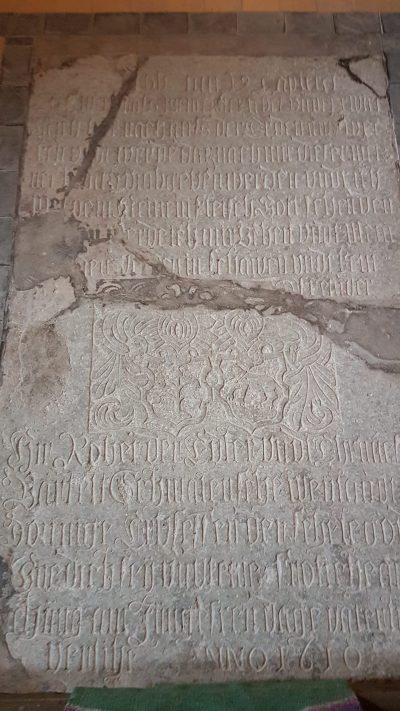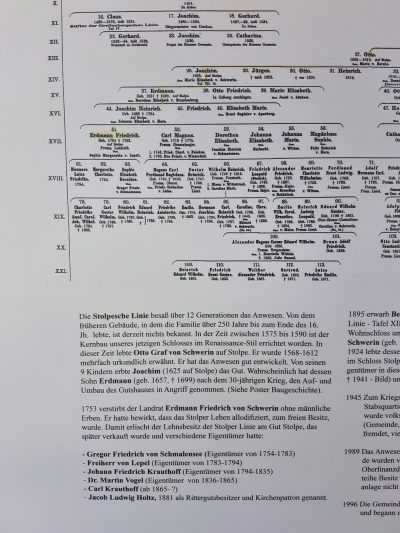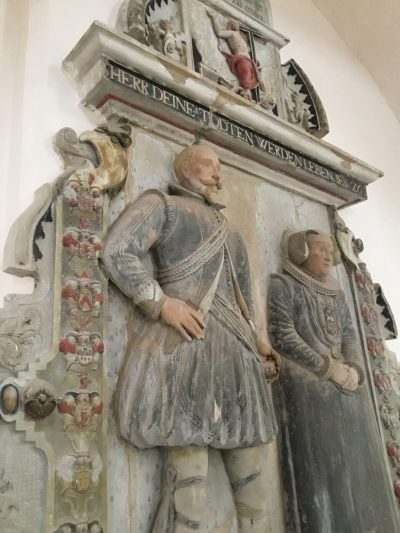On the 'Schmalensee Trail'

In August 2018 we headed to the North of Germany to find and follow the footsteps of the early Von Schmalensees.
Here’s the travel journal based on the emails sent to the family while we were traveling.
Date: 15. August 2018 at 10:21:43 CEST
Subject: On the ‘Schmalensee trail’
Hi all!
We have decided to spend our summer vacation in the Mecklenburg lake region. We are in a lovely house with a fenced in yard, so even the dog has some space for himself. We chose this area not just for the swimming, boating and fishing but also because it’s very close to were our German ancestors lived. Most of the places we want to see are all easy day trips from here. The islands of Rügen and Usedom will each take longer and are planned for next week.
We discovered that Bartelt, the oldest known direct ancestor, served as an advisor to Archduke Witzislaw VI in the Hanseatic town of Demmin in 1386, which is the town closest to where we are staying.
Our first stop, of course, was to Dönnie, the “knightly” estate held by the family for over 400 years. The village itself was less than underwhelming but the manor house, which is now a hotel, was rather nice on the outside. The original house was destroyed twice over time, and the current one was built in the 19th century but worth a look nonetheless. We plan on returning once more, maybe to spend a night but at least to walk the grounds once.
We then headed to the tiny town of Rakow to hopefully see the small church where two ancestors are buried. The travel journal from 2005, which the Swedish relatives sent me, didn’t make us too hopeful as they had written the church was locked, disused and even had a tree growing out the side. They were unable to find anyone to let them in. Much to our surprise, we found things to be just the opposite. We located the deacon who gave us a private tour of this small church, which was actually in good condition. He was quite excited to learn the family is alive and well, albeit not in Germany itself.

The deacon also provided me with a book on this and other churches in the region. It also contained a photo of our crest, which had been painted in 1955 on the left wall along with other crests from influential families

This is one of only two graves I know about in Germany. The other is near Potsdam and we will save that for another trip to Berlin. We plan on seeing some of the houses where family lived and I will send updates as we go along.
Hoping this finds you all well.
Love, Jan and co.
Date: 20. August 2018 at 22:27:54 CEST
Subject: A grand day out
Hi all!
Today was one of our most successful days. I cannot wait to share it with all of you. Leaving Brian and the dog at home, who both had had their fill of culture and sitting in the car, the remaining three of us headed off to the beautiful old city of Greifswald this morning. The city is known for its university, and several Schmalensees even studied here. We first set off for two art supply stores to get the remainder of what we needed for our attempt at grave rubbing—not grave robbing. Needless to say, we parted with lots of cash.



We then had a lunch of local fish sandwiches and waited for the rain to pass. The area is suffering one of the worst droughts ever recorded (the lake where we’re staying is three feet below normal), so it was actually a welcome sight. After that we left for our appointment with the deacon in Rakow. Once we arrived, we got straight to work trying out various types of paper and media. Believe it or not, a big black crayon worked best. Being the good parents that we are, we then left Jacqueline to work alone while we had coffee with the deacon in the rectory.

He pulled out many old record books from 1623 to 1756. There were numerous mentions of Schmalensees, including one about receiving payment of 12 Groschens to ring the bells for the funeral of a male Schmalensee. I will send some photos of these in a separate email.
We asked him about donating a floral arrangement for the church service sometime but he said that isn’t customary. He then opened a safe and brought out an amazing old chalice. He pointed out the date engraved on the bottom, which was 1600. He said that Bartelt (or Bartholdt), whose grave is in front of the altar, would have used this chalice during communion in the church in the last 10 years of his life. The pastor said it was in dire need of repair before it could be used in church services again; the stem is loose and there is a crack in the bowl. He said, if we wanted, we could pay for the repair as a gesture to the church. We said we were very interested and would like to see the estimate when he gets it (also hoping we can afford it). I like the thought of some of the inheritance going towards something like this.

Well that’s about it for this exhausting but fruitful day. Tomorrow we head to the island of Rügen, where also some people lived but I have no clue where to look.
Hugs, J
Date: 20. August 2018 at 22:53:28 CEST
Subject: Records
As promised, here the pictures from the old record books of Rakow.
Date: August 21, 2018
Subject: Off to Usedom
Today we set off for the island of Usedom, where Gregorius Friedrich von Schmalensee owned the knightly estate in Stolpe from 1754 -1783, where he served as District Administrator. Sadly, a wedding was held in the building that day, and we were unable to tour the premises.



Date: 24. August 2018 at 22:03:44 CEST
Subject: Our last day in Verchen
Hi all!
Today was our last full day in the area. On our trip to Rügen we drove to see the white limestone cliffs, rather like the white cliffs of Dover in England. Then, since the weather was so great and we didn’t know where to look for any landmarks, we headed to the nearest dog beach and spent the afternoon there. Much to Jacqueline‘s chagrin, this dog beach was also a nudist beach, so she saw more sights than she reckoned with. The rest of us were a bit more relaxed about the whole thing and, no, we all had swimsuits on. We stayed until jellyfish moved in a few hours later.
Today we checked the final things off my list. Our first stop was a return trip to Dönnie. We looked at the outside again but since no one was there, it felt wrong to just barge in and walk around the place. So we left but not before taking some better pictures.

This little village basically consists of two streets with two rather unimaginative names:

According to the deacon in Rakow and as noted in the books by Bergmann, Dönnie had a chapel and a crypt but were both abandoned in the 1500s. He showed me a record of the family purchasing the church contents at the time. This would have also been around the time they started attending the church in Rakow as it was the closest

Our next stop was in the tiny town of Grellenberg, which had also been in the possession of the family for a long time. We had already known that the building was abandoned and in a horrible state, undergoing what one website called a demolition by the elements. Sadly, we learned from the locals that the roof collapsed 10 years ago and what was left was fenced in as a safety precaution.
Here a photo from 1999, courtesy of Herr von Roy.



Our next stop was the church in Franzburg. As mentioned in the family history, it contained a so-called epitaph from 1615 of the Berglase family, which included our crest as we were related to his wife. We arrived to find the church locked but were able to locate the pastor, who simply gave us the keys. Given this carved sandstone memorial is four meters high, we didn’t have too much trouble finding it. We located the crest on the left side.
Our final stop of the day was in Gross Zetelvitz. Cord Schmalensehe lived here in the 1500s. It appears that several families now live here, so we only took a few photos from the outside. It doesn’t seem to have changed much from the photo in Bergmann’s book taken sometime in the 50s or 60s. His photo was from the front, albeit ours is taken from the back as there were some hideous structures standing right in front of it.


And that, I’m afraid, ends our little adventure here up north. We came across friendly, kind people wherever we went. There is a simple beauty to this part of country. In many ways, however, it feels like not much has changed since the Wall fell. Many buildings are run down and / or deteriorating. It didn’t feel at all like the rich, prosperous Germany I have come to know. We were amazed at the lack of infrastructure in many small towns like the one where we were staying. Demmin, a good 20-minute drive away, had the closest supermarket. We were also amazed at the lack of restaurants, especially today. We had planned to eat lunch somewhere in Franzburg, which is a relatively big town, and found nothing open anywhere. At quarter to four, we managed to find the only McDonalds in the entire area, and when you’re starving even that tastes good.
We have a ‘date’ tomorrow with one more ancestor on our way for a three-day stay in Dresden. We decided to make a little detour tomorrow to see the grave I mentioned in a previous mail. I learned through an acquaintance that a Schmalensee is buried next to her husband in the church in Plessow, near Potsdam. I have called ahead and they have promised me they would leave the church unlocked for us. Keep your fingers crossed that this works out.
J.
Date: 25. August 2018 at 22:28:47 CEST
Subject: Final entry
Hi All!
We have arrived in stunning Dresden after making a detour to Plessow, where not one but two Schmalensees were buried. The deacon of the church was waiting for us when we got there. He informed us that the crypt had been emptied years ago and the caskets were buried in the cemetery. The tombstone, however, was affixed to the outside wall, which is visible in the photo of the church.

The inscription uncovered something very interesting, namely that it makes zero mention of the fact that Friedrich Ludwig von Rochow was first married to Susanne Margarete Wegely (1727-1785), a very wealthy widow. It even goes so far as to call Anna Karoline Dietrica von Schmalensee his first wife and Anna Dorothea Christine von Schmalensee his second wife. He was 28 at the time of his actual first marriage to Wegely, when she herself was 46.
Anyway, I know from records that Anna Dorothea gave him four daughters and three sons. Two daughters and one son were also buried in the crypt with them. 1801 must have been simply a horrible year: in April one daughter died, in May one son, and then in June Anna Karoline herself. After she died, Friedrich then married her younger sister Anna Dorothea almost one year to the day after her sister had passed.
That now finally wraps up our little journey of, as the kids would say, looking for dead people. I found it made the family history suddenly more tangible, seeing places and things I’d only ever read about. The deacon in Rakow has given me a wealth of information, which I will share with you once I start digging through it. Some of this even contradicts what Bergmann had written. I will keep you posted.
Thank you for reading. It’s been quite a trip.
Hugs, J.













